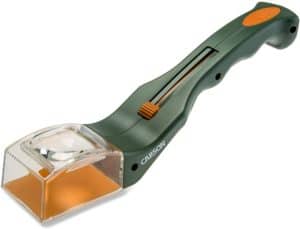Creepy crawlers invading your camper can make life uncomfortable. Although pests do find ways to break in to RVs, there are multiple ways to remove them.
To get rid of tiny bugs in a camper, there are plenty of tools to use, including: Fly swatters, a no-harm bug catcher, fly tape, repellents, essential oils, boric ant killer, keeping laundry clean, and bleach. You can prevent common RV pests such as flies, gnats, sewer flies, and bed bugs, by keeping the camper uncluttered, and sealing up any potential RV openings.
Here, you’ll learn about common RV bugs, how they get in, how to remove them, ways to prevent future infestations, and what to avoid.
What Kinds of Bugs Are the Most Common in RVs?
Some of the most common flying insects you’ll find in your RV include houseflies, mosquitoes, and moths. These pests typically gather around light sources.
Other common creepy crawlers in RVs are spiders, silver fish, ear wigs (“pincher bugs”), bed bugs, and fleas. These bugs crawl into tight crevices, or like in the case of fleas, can come in the front door via your pet, or even hang on to your clothes, jumping off and burrowing into RV furnishings.
Ants are not usually a problem in RVs, especially if you’re parking on open land. However, if you’re staying on campgrounds where there are multiple RVs parked, ants may find their way into your camper looking for food and water.
Like ants, bees, termites, wasps, and centipedes don’t usually find their way into RVs. Of course, this is location dependent; these insects could creep in once in a while, but it is rare.
How Do Bugs Get In?
Before we try to eliminate insects and pests that have found their way into your RV, we first need to find out how they get in. Here are some of the easiest ways bugs invade your camper:
- Gaps in the window/door screen. Do you have tears on your RV’s screens? If so, you’ve found one common entry point for bugs. Spaces between the window/door and the frame could also let bugs into your camper.
- Items touching your RV. Sometimes creepy crawlers need a little boost to make it into your camper. If you have your camper’s tow chain laying on the ground, it could serve as a bridge through which bugs can access your trailer. Patio tables, or plants touching the ground could also help bugs get into your RV.
- Light bulbs on a night. If you leave the lights on a night, you’re sure to attract plenty of flying bugs. Even with your doors and windows closed, these insects will seize any opportunity to get in. If you step outside for a moment, hoards of these waiting insects will try to rush inside.
- Tiny holes. Small holes around pipes, water heaters, and vents can also invite these unwanted visitors. Regular RV wear and tear can make holes around these areas.
- Trash close to the camper. Always dispose of your waste by tossing it a significant distance from your trailer. House flies, fruit flies, and other insects that are attracted to trash can swiftly move on to your trailer if your trash is left too close by.
- Access to sewage. If you’re leaving your sewage tank valves open, that’s an open invite for sewage flies to come and breed. These flies typically enter and breed in your RV’s sewage tank, with adult flies flying out of the toilet and into the RV’s living space. These flies spend most of their time near waste, where they pick up several microbes and bacteria. They can deposit these germs in your RV which could have potentially dangerous health implications.
How to Get Rid of Bugs in Your Camper
Once you’ve identified the bugs living in your camper, you’ll need to figure out how to remove them. The method of insect removal depends on the type of bugs that have infested your home.
Here are a few techniques you can try:
- Fly swatter. You can go with an electric or traditional option. Traditional fly swatters come in handy anytime one of those pesky flies comes too close for comfort. On the downside, you’ll have a bit of clean up to do. And electric swatter running on a battery uses an electric current running through its mesh to kill insects. There are no crushed bug pieces left behind! This method is useful if you don’t have a severe fly infestation.

- No-Harm Bug Catcher. If you don’t mind getting a little up close and personal with a stowaway bug, this no-harm bug catcher allows you to catch the invader, and let them go outside. There’s no mess to clean up, and is very easy to use.

- Fly Tape. This sticky paper, usually containing attractant, lures flying insects for quick elimination. To use this, just unravel the paper, roll, and place it in areas where you would typically see the flying insects congregate. Using fly tape is best when your RV is parked and stationary; Such sticky tape out in use while the RV is in motion could easily dislodge and stick to unwanted surface like the floor and walls.
- Essential Oils. Reach for that bottle of peppermint oil or eucalyptus because it could be your secret weapon against a bug infestation. Insects typically find these oils’ intense smells suffocating and try to find their way out. Mix a few drops of essential oils with water in a spray bottle. Spray this mixture in corners where insects love to hide. (Peppermint oil also helps to Get Rid of Mice in You RV!)
- Household insect repellents. You might have other items in your pantry that could help you eliminate the bugs in your camper. For instance, vinegar makes and excellent insect repellent. Diluted vinegar, citrus juice, or citrus peels in a spray bottle could help with your bug problem. Other hacks you could try include onions, turmeric, mint, black pepper, red chili, and detergent to help get rid of bugs.
- Mosquito repellents. You could choose any of the available mosquito repellents on the markets to eliminate mosquitos and other insects. Burning mosquito coils and insect repellent candles are also an excellent way to prevent these flying insects from coming inside.

- Boric ant killer. If your camper is at a location where an ant infestation is a real threat, consider getting the ants first with boric ant killer. You can also use cornmeal as a less aggressive alternative.
- Clear clutter and do your laundry. Clearing clutter removes potential bug hideouts. If you have bed bugs, you’ll want to bag up your sheets and everything else that might have had contact with the bugs. Using your household washer might not be enough to get the bugs out. If possible, use a commercial laundromat as the high heat of the machines should help eliminate bed bugs. Use new bags to transport your freshly washed laundry.
- Use bleach. If you have sewer flies breeding in your RV sewer tank, consider using bleach to kick them out. Pour a dilute bleach solution down your toilet and into the black tank. Let the mixture soak for a few hours or through the night. Rinse the next morning, and hopefully, you won’t have sewer flies to deal with anymore.
Ways to Prevent Future Bugs in Your Camper
We’ve learned how to get rid of those nasty bugs, but keeping them from coming back is equally important. If you can’t prevent bugs from entering your camper, you’ll always be fighting to eliminate them. Here are a few ways to prevent bug from entering your RV:
- Don’t leave the light on a night. These lights will attract lots of flying insects to your camper. Once you open the door or crack open the window, a swarm of insects will find their way in.
- Clean up the clutter. Organize shelves, and discard unwanted materials. Crawling bugs like to hide in these crevices, so don’t give them a place where they can get too comfortable.
- Look for entry points. Start by examining your windows, pipes, vents, and other openings to the outdoors. Fill any holes you find around these areas to keep bugs out.
- Use household bug repellent. Sprinkling some detergent around your RV tires to prevent ants from climbing into your RV is a pretty good way to avoid infestation. Laying down a line of cinnamon at bug entry points can also help keep crawlies away.
- Dispose of waste correctly. Having your waste close to your camp is a sure invitation for pests and bugs. Consider bagging your trash and disposing of them properly.
Things to Avoid
There are numerous techniques to get rid of bugs or prevent their entry into your RV. However, not all of these methods are friendly to the environment and some can end up causing more harm than intended. Here are a few bug removal methods you might want to avoid:
- Bug lamps. These are effective at killing bugs. However, they also attract insects from miles away to kill them. You could even attract more bugs than you can handle.
- Bagged fly traps. The chemoattractants in these traps can get flies from far away to change course, and head over to your camp. The smells from the attractant can also be off-putting for people.
- Oily bug sprays. Oil residue from these sprays can stick around in your RV, leaving you to clean it off dirtied surfaces.
- Chemical bug sprays. Consider using these sparingly. They can be toxic to both humans and pets when ingested or absorbed through the skin.
Wrap Up
If bugs make their way into your RV, know you have plenty of ways to remove them. Depending on the types of insects you’re trying to eliminate, you can use essential oils, fly tape, an electric fly swatter, and various other means of removal.
To ensure these insects don’t re-enter your RV in the future, take preventative measures: Caulk open seams in windows and doors, keep your camper clean, take out trash frequently, and close off any potential openings in and around the RV.

